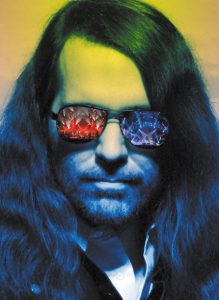Trans-Siberian Orchestra remembers Baltimore’s brave Angela Dawson
Paul O’Neill is deep in conversation as his limousine glides through traffic to the Wachovia Arena in Philadelphia when a passerby catches his eye.
“Stop the car. Stop the car,” said O’Neill, founder and director of Trans-Siberian Orchestra, who spotted a 12-year old girl who had fallen while walking with her mother. After grabbing the door handle and leaping from the still-moving car, O’Neill sprinted to the pair, introduced himself, and consoled the child before giving them tickets for that night’s TSO show and some spending money for souvenirs.
“Well, you know, she’s just about my daughter’s age,” said O’Neill when he returned to the car and was met with incredulous statements by other passengers. “I didn’t want her to feel badly.”

To many O’Neill is best known as the mastermind behind TSO – known for stage shows something akin to Aerosmith plus Led Zeppelin within a modern-day “Jesus Christ Superstar” rock opera format complete with lasers, pyrotechnics, superb rock music, a story narrator, and images created by internationally renowned fantasy and science fiction illustrator Greg Hildebrandt.
Since the band’s first show 13 years ago, fans around the world eagerly await TSO’s annual holiday pilgrimage; they’re especially jubilant now because TSO is touring in support of “Beethoven’s Last Night.”
What many don’t realize is that for all his solid-gold rock credentials – underscored by his black-leather-jacket-and-black-jeans-and-ever-present sunglasses attire – O’Neill is as in tune with historic and contemporary struggles against oppression and evil as he is with the 60-piece orchestra (plus chorus) that bears the TSO name.
O’Neill is a fascinating man, incredibly intelligent and quick witted with an encyclopedic knowledge of subjects ranging from ancient Greece to modern rock. Perhaps at one time O’Neill’s life was all rock-and-roll, but that all changed with the birth of his daughter. Now he sees the world through her eyes and worries how the world can impact her.
“When I was young I never thought about having a child,” he said. “I never thought about losing a child. I think about that now.”
Just a few years after his daughter was born, a news story caught his attention. It was the tale of Baltimore’s Angela Dawson who fought to rid her east Baltimore neighborhood of drug dealers. She pushed for the dealers to leave. The dealers fought back with violence. Dawson was undeterred. When drug dealers firebombed Dawson’s home for the second time, she and her five children died inside. Her husband Carnell Dawson, died a few days later as a result of the fire.
“I am in awe of people like her,” said O’Neill of the woman he knew only through newspaper accounts. “This is someone who went the extra mile, to do what she knew was right, to protect her children and all the children in that neighborhood.”
To call the resultant “Night Castle” – the 2009 release that O’Neill wrote and produced — a rock album is akin to classifying JRR Tolkien’s writings as fairy tales. Yes, the music is solid rock, but it’s much more than that.
The music is part of a story – as outlined in the 70-pages of album linear notes–that mingles historic and fictional characters and events into a tale of sin and redemption, good vs. evil, love and loss. Imagine Harry Potter, The Twilight Saga and Horatio Hornblower and you begin to understand the complexity of “Night Castle,” which is supplemented by a high-tech Web site.
Pamela Carter, a former city council member and now director of the Dawson Family Safe Haven Center, located on the site of the Dawson’s former home, knows something about facing evil.
She was sound asleep the night of October 16, 2002 when she awoke to the smell of thick, pungent smoke. Going to her bedroom window, she saw flames shooting from the Dawson home and watched as people gathered in the cold, rainy gloom. Most were crying. Some were shrieking.
“I still get chills thinking about it,” said Carter, as children’s jubilant shouts of laughter drifted from the rooms of what is now Dawson center. “I remember walking outside and people were just crying. One of my neighbor’s was screaming `They burnt the babies, they burnt the babies.’ It was quite some time before I could hear a fire truck’s siren and not feel terror.”
Reginald Scriber, Deputy Commissioner of Community Services, was one of the city officials standing outside the Dawson home as it burnt.
“The thing that struck us more than anything is that this woman, this family, could not die in vain,” he said while sitting in the Dawson Center where children crowded around him to show him their homework or just ask for hugs. “We needed to find funding to carry on their work.”
As a result, the City began new processes to handle calls from citizens in imminent danger and raised money that transformed the row house, valued at $12,000, into a $1.5 million haven for about children and families that opened in April 2007.

Now it serves as a haven where about 50 school age children each day do their homework, play, and even take foreign language classes; adults visit to learn skills such as how to apply for jobs.
“Miss Pamela, I have to show you this,” said 3-year old Toni holding a red-and-blue crayoned picture of Spiderman as she slowly opened a door to the conference room where Carter sat.
Wearing small gold hoop earrings and beads in her meticulously styled hair, the young girl’s eyes grew solemn as Carter praised the work and gave the girl a hug.
“On any given day when I think of the tragedy and then I hear the children laughing and talking, I know the Dawsons truly did not die in vain,” said Carter after the child was seated downstairs, happily munching a snack. “Their spirits truly live here…I just want something positive for the kids.”
There’s little doubt that the TSO “Night Castle” tour, CD and other components –dedicated to Dawson and other such heroes – add to the positives.
“Our first job is to entertain and we try to do that,” said O’Neill. “But with all the perks in entertainment there is also an incredible responsibility. The power of the arts to change the world is staggering.”
O’Neill talks about the positive influence Charles Dickens’ writings had in revolutionizing child labor laws, while films such as “Triumph of the Will” propelled the Nazi party to greater power in the 1930s.
“So many kids learn history from movies and other arts and it’s so important not to twist it,” he said. “It is important children are educated and it doesn’t have to be boring…If one child learns more history because of Night Castle, then I win.”
Show: Trans-Siberian Orchestra, Sunday, April 29, 2012, First Mariner Arena, 201 W. Baltimore Ave., 410-547-SEAT; Tickets: $39 to $59
Nancy Dunham is a music journalist based in Washington, D.C. Her work appears in Relix, YRB, Spinner, M Music & Musicians, American Songwriter and other publications.

